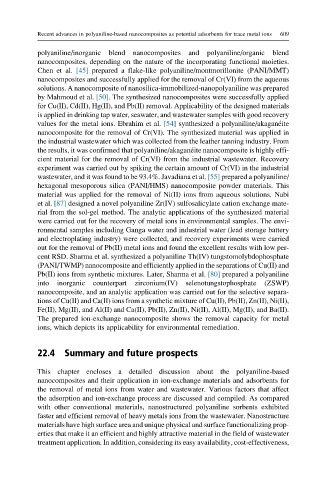Page 663 - Polymer-based Nanocomposites for Energy and Environmental Applications
P. 663
Recent advances in polyaniline-based nanocomposites as potential adsorbents for trace metal ions 609
polyaniline/inorganic blend nanocomposites and polyaniline/organic blend
nanocomposites, depending on the nature of the incorporating functional moieties.
Chen et al. [45] prepared a flake-like polyaniline/montmorillonite (PANI/MMT)
nanocomposites and successfully applied for the removal of Cr(VI) from the aqueous
solutions. A nanocomposite of nanosilica-immobilized-nanopolyaniline was prepared
by Mahmoud et al. [50]. The synthesized nanocomposites were successfully applied
for Cu(II), Cd(II), Hg(II), and Pb(II) removal. Applicability of the designed materials
is applied in drinking tap water, seawater, and wastewater samples with good recovery
values for the metal ions. Ebrahim et al. [54] synthesized a polyaniline/akagan eite
nanocomposite for the removal of Cr(VI). The synthesized material was applied in
the industrial wastewater which was collected from the leather tanning industry. From
the results, it was confirmed that polyaniline/akagan eite nanocomposite is highly effi-
cient material for the removal of Cr(VI) from the industrial wastewater. Recovery
experiment was carried out by spiking the certain amount of Cr(VI) in the industrial
wastewater, and it was found to be 93.4%. Javadiana et al. [55] prepared a polyaniline/
hexagonal mesoporous silica (PANI/HMS) nanocomposite powder materials. This
material was applied for the removal of Ni(II) ions from aqueous solutions. Nabi
et al. [87] designed a novel polyaniline Zr(IV) sulfosalicylate cation exchange mate-
rial from the sol-gel method. The analytic applications of the synthesized material
were carried out for the recovery of metal ions in environmental samples. The envi-
ronmental samples including Ganga water and industrial water (lead storage battery
and electroplating industry) were collected, and recovery experiments were carried
out for the removal of Pb(II) metal ions and found the excellent results with low per-
cent RSD. Sharma et al. synthesized a polyaniline Th(IV) tungstomolybdophosphate
(PANI/TWMP) nanocomposite and efficiently applied in the separations of Cu(II) and
Pb(II) ions from synthetic mixtures. Later, Sharma et al. [80] prepared a polyaniline
into inorganic counterpart zirconium(IV) selenotungstophosphate (ZSWP)
nanocomposite, and an analytic application was carried out for the selective separa-
tions of Cu(II) and Ca(II) ions from a synthetic mixture of Cu(II), Pb(II), Zn(II), Ni(II),
Fe(II), Mg(II), and Al(II) and Ca(II), Pb(II), Zn(II), Ni(II), Al(II), Mg(II), and Ba(II).
The prepared ion-exchange nanocomposite shows the removal capacity for metal
ions, which depicts its applicability for environmental remediation.
22.4 Summary and future prospects
This chapter encloses a detailed discussion about the polyaniline-based
nanocomposites and their application in ion-exchange materials and adsorbents for
the removal of metal ions from water and wastewater. Various factors that affect
the adsorption and ion-exchange process are discussed and compiled. As compared
with other conventional materials, nanostructured polyaniline sorbents exhibited
faster and efficient removal of heavy metals ions from the wastewater. Nanostructure
materials have high surface area and unique physical and surface functionalizing prop-
erties that make it an efficient and highly attractive material in the field of wastewater
treatment application. In addition, considering its easy availability, cost-effectiveness,

